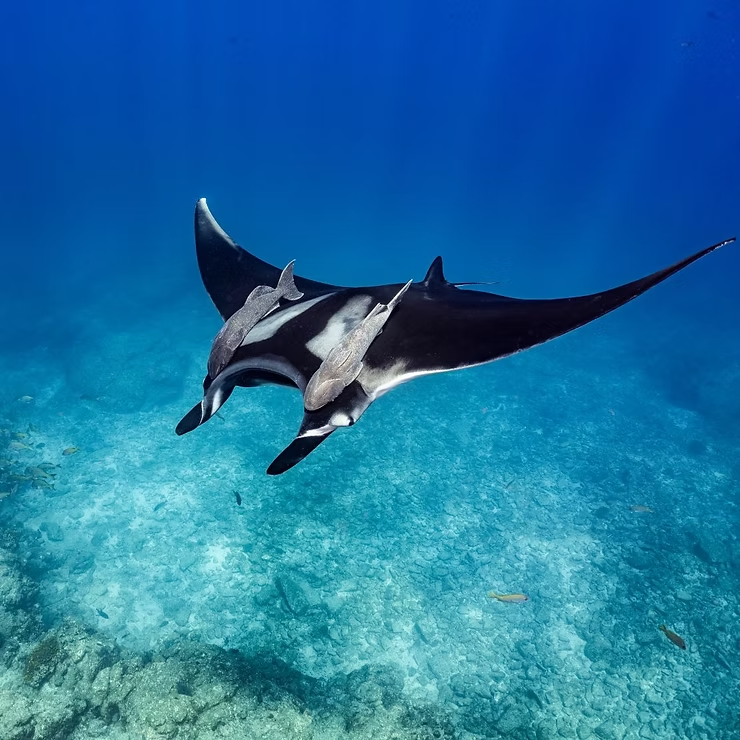The Graceful Giants of the Ocean
Manta rays are among the most awe-inspiring marine animals, celebrated for their majestic size, intelligence, and fluid movements. Often compared to underwater dancers, they glide with effortless grace, playing a vital role in maintaining balance within marine ecosystems. Understanding their biology, behavior, and challenges helps us appreciate why conservation is so essential.
Characteristics and Species
These gentle giants are easily identified by their triangular pectoral fins, horn-shaped cephalic fins, and wide, flat bodies. Their coloration ranges from black to white, often with distinctive markings that serve as a natural fingerprint.
Two Main Species
- Reef mantas (Mobula alfredi) inhabit shallow tropical waters, often gathering near coral reefs in large groups.
- Oceanic mantas (Mobula birostris) roam the open sea and can reach wingspans of up to 7 meters.
Both species are highly intelligent, with the largest brain-to-body ratio of any cold-blooded fish.
The Ocean Ballet: Movement and Hydrodynamics
Manta rays move with precision thanks to their vast pectoral fins, which function like wings underwater. Their streamlined, diamond-shaped bodies reduce drag, while tiny dermal denticles on their skin minimize turbulence. This combination allows them to perform banking turns, sudden bursts of speed, and synchronized group swimming that resembles a carefully choreographed performance.
Habitats and Migration
Mantas thrive in warm tropical and subtropical waters, often frequenting plankton-rich upwellings and coral reef cleaning stations. Seasonal migrations see them traveling long distances in search of food and breeding grounds. However, human activity poses significant threats to these habitats, including pollution, overfishing, and the effects of climate change.
Social Behavior and Courtship
Manta rays are surprisingly social, engaging in behaviors such as playful somersaults and intricate courtship rituals. During mating displays, males follow females in coordinated “trains,” showcasing agility until a mate is chosen. Groups often swim in synchrony, a behavior that strengthens bonds and aids in feeding efficiency.
Conservation Challenges and Successes
Despite their grace, manta rays face serious dangers. Overfishing, demand for gill plates, and habitat destruction threaten their survival. Conservationists have responded with protective legislation, marine sanctuaries, and community-based programs that safeguard their future. Responsible tourism—such as diving with mantas without disturbing them—also plays a critical role in conservation efforts.
Encounters and Cultural Significance
Diving alongside manta rays is a transformative experience, often described as witnessing an underwater ballet. Culturally, mantas have long been symbols of freedom and guardianship, appearing in folklore, art, and modern conservation campaigns. Their enduring presence in human imagination underscores their importance beyond biology.
Why Mantas Matter
Manta rays regulate plankton populations, enrich ecosystems through nutrient cycling, and act as indicators of ocean health. They also contribute to local economies by attracting divers and inspiring marine conservation initiatives. Protecting them is not just about preserving a species—it’s about maintaining balance in the oceans that sustain us all.
Conclusion
The dance of manta rays reminds us of the beauty, intelligence, and fragility of marine life. Their survival depends on global cooperation, responsible practices, and a commitment to conservation. By protecting these gentle giants, we ensure that future generations can marvel at their underwater ballet and the thriving ecosystems they support.

